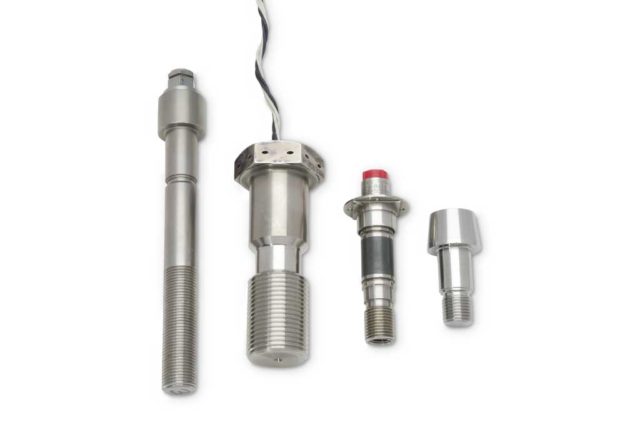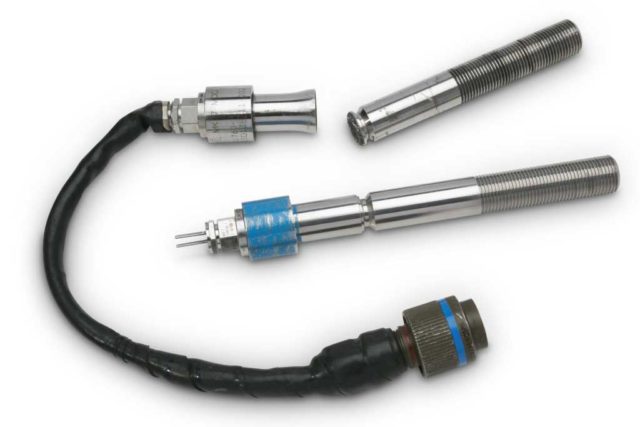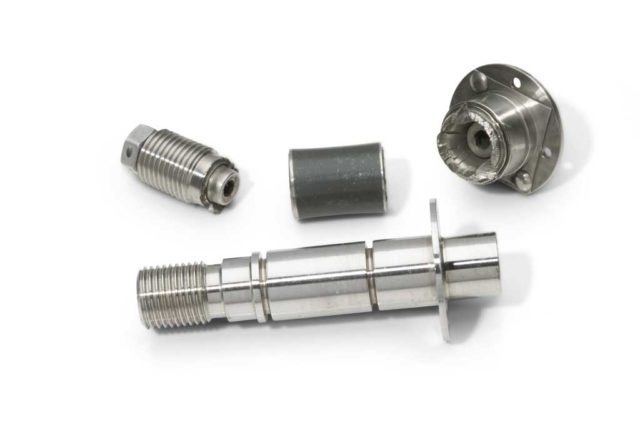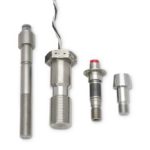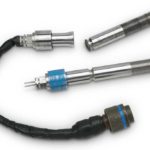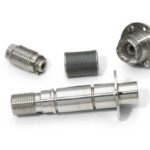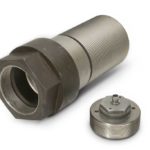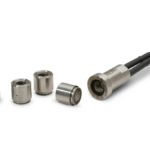Explosive Bolts
Product Description
Explosive bolts efficiently secure two objects and strategically explode, jettisoning those objects on command when commanded. These bolts initiate a perfect failure at the pivotal moment they need to. This part is designed for missile, launch vehicles, spacecraft and capable of marine applications where rapid structure separation is demanded. Standard explosive bolts and ridge cut explosive bolts are available in a wide range of sizes, configurations and tensile capacities from as little as 200 pounds to as much as 1,000,000 pounds. As an explosive bolt manufacturer, our experts are here to support you in meeting your structural loading, envelope and environmental requirements and guide you on ways to mitigate shrapnel and products of combustion.
Key Features
- Can be removable
- Low fragmentation
- Fragmentation can be controlled
- Separate cleanly
- Immune to malfunction due to vibration
- Withstands high shock loads
- No moving parts prior to operation
How An Explosive Bolt Works
They are used for fastening mating components or devices together to then allow rapid structural separation when commanded. Also known as pyrotechnic fasteners, explosive bolts feature machined geometries to control the separation location and breaking strength. An explosive charge, located within a machined cavity in the bolt, or externally for Piston Bolts (Propulsive Bolts), provides the energetic stimulus required to cleanly separate the bolt at the predetermined break plane.
By design, an explosive bolt will separate at a specified break plane controlled by the machined geometries. Surprisingly, there are four different types of bolts. They can be categorized into two: explosive bolts and separation bolts. The difference being whether you use explosive detonating material or a pyrotechnic pressure generating material. Another distinction is that with explosive bolts, the combustion gases are vented when the bolt separates whereas with Separation bolts the combustion products can be contained. The selection, of course, will vary depending on the application requirements. A standard explosive bolt simply uses enough explosive charge, pressed into a counterbore of the bolt. When fired, the detonation exceeds the bolt strength.
There are a large range of explosive and separation bolt sizes and strengths. From a design consideration, for explosive bolts to break, there must be room for the shank of the bolt to expand within the area above the break plane.
Our Explosive Actuated Bolts are designed to separate cleanly along a predetermined fracture plane. An explosive charge, located within a cavity in the bolt, provides the energetic stimulus required for bolt fracture. Explosive bolts are supplied in a wide range of sizes and configurations tailored to suite structural loading, envelope and environmental requirements. The bolts we supply range in tensile capacity from as little as 1400 pounds (.25 inch diameter) to as much as 557,000 pounds (5.75 inches diameter).
An explosive charge within the center bore of the bolt provides the energetic stimulus required to fracture the bolt. Explosive gases are vented.
For standard explosive bolts, there is some fragmentation, however, the mating structure contains much of the bolt.
The head of the bolt remained with the structure due to the expansion. Standard Pressure Actuated Pyro Bolts provide maximum tensile and fatigue strength for the available envelope at minimum cost. Tensile, shock and hoop stresses developed from an internal detonation cause failure of the bolt along predetermined stress riser at the separation plane. Shrapnel and products of combustion are not contained.
► Standard Explosive Bolt: enough explosive charge to fracture the bolt
If you need the bolt to be removable, this can be accommodated if you allow the expansion to occur inside the bolt outside diameter, for example, you have a 1 3/8 bolt but the shank at the break plane location is only 1 inch in diameter.
A ridge cut bolt is similar in construction, however, a design feature of the bolt allows for the detonation shock wave to reflect on itself and that constructive interference exceeds the bolts tensile strength, breaking the bolt. This design method virtually eliminates fragmentation and allows for bolt expansion. Ridge-Cut Explosive Bolts employ shock wave mechanics to realize reduced shrapnel generation while maintaining high tensile strength. Explosive gasses are vented. The explosive load is pressed directly into the bore of the bolt. Shock waves emanating from the detonation pulse reflect from external surfaces to intersect and create tensile fracture along a conical path from the base of the bore to the edge of the notch on the outside diameter of the bolt.
► Ridge-Cut Bolt: employ shock wave mechanics to realize reduced shrapnel generation
Energy Inputs
Initiation of Explosive and Separation Bolts. There are three ways; electrical, explosive transfer line, and mechanical. One might argue that there are only two ways because the explosive transfer lines are functioned either electrically or mechanically.
Electrical Initiator or Detonator
Most electrical initiators/detonators are functioned using 3.5 amps which is in accordance with MIL specs and standards. These devices have also been tested as high as 22 amps. Cap discharge methods can be used as well as long as enough energy is provided.
Explosive Transfer Line
Different transfer lines can be used (det cord, Rapid Deflagrating Cord, shock tube, etc.) The transfer line end-tip is the important feature and will need to be matched with the bolt design for proper detonation transfer.
Mechanical Initiation
Mechanical initiation can be achieved with a lanyard type device or a T-handle device. T-handles will use a transfer line to mate with the bolt downstream of the handle.
Redundancy
Not all applications require redundancy.
Electrically, initiators and detonators can use a second bridge wire. A single firing circuit could fire both bridges or two independent firing circuits could be connected to each of the separate bridge wires.
Similarly, two separate initiators or detonators could be used. Either one or both will function the bolt.
Two inputs/One Break-plane
There are opposing initiators, one at each end of the bolt with a single break plane. Either one or both, when functioned, will break the bolt at the
same break plane.
Two Inputs/Two Independent Break-planes
There are opposing initiators at the ends of the bolt, but in this case the two break-planes are independent of each other. They can be functioned separately or at the same time.
Two Inputs / Two Simultaneous Breakplanes
With opposing inputs, but either input or both will break the bolt in both locations. This is especially useful in hinge designs. This particular bolt is used on a hinge, and when fired, releases the aircraft canopy during a pilot emergency egress.
Specifications
-
- Input Stimulus, Typical
3.5 amp (when electrically initiated)
TLX or SMDC input
4.5 AMP/4.1 millisecond - Tensile Strength
Up to 550,000 lbf - Operating Temperature
Designs as low as -65 °F and up to +270 °F - Separation Time, Typical
<10 milliseconds after application of All-Fire input stimulus
<5 milliseconds at greater currents - Applicable Specifications
Qualified for:
MIL-DTL-23659
Mil-C-83124
- Input Stimulus, Typical
NASA NHB5300.4(1C)
Mil-STD-1512
- Hermeticity (pre-function)
Designs that comply with 1 x 10-6 cc He/sec at 1 atm
FAQ's
-
What's the difference between explosive and separation bolts?
The difference between explosive bolts and separation bolts is you use either explosive detonating material or a pyrotechnic pressure generating material.
-
What causes a bolt to fail at the separation plane?
For an explosive bolt the internal detonation exceeds the bolt strength.
-
What is a pyrotechnic explosive bolt?
Also known as pyrotechnic fasteners these are machine geometries on a bolt which control the separation location and breaking strength when initiated.
-
What is the thread size?
Multiple sizes are available based on your needs.
-
What is the tensile strength?
Designed to match the application.
-
What is the initiation method?
Electrical or mechanical.
-
Is there fragmentation?
No.
-
What is the operation method?
Pyro hot gas or cold gas.
